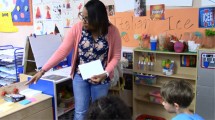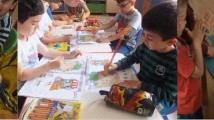Abstract
Writing is a critical emergent literacy skill that lays the foundation for children’s later literacy skills and reading achievement. Recent work indicates that many early childhood programs offer children materials and tools for engaging in writing activities but teachers rarely are seen modeling writing for children or scaffolding children’s writing attempts. Early childhood educational settings hoping to support children’s literacy development should provide multiple opportunities for children to observe teachers model writing, provide teacher support and scaffolding for children’s writing attempts and engage children in meaningful writing in their play. This paper provides twelve research-based guidelines for supporting children’s writing development in early childhood classrooms.
Similar content being viewed by others
References
Aram, D. (2005). Continuity in children’s literacy achievements: A longitudinal perspective from kindergarten to school. First Language, 25, 259–289.
Bear, D. R., Invernizzi, M., Templeton, S., & Johnston, F. (2008). Words their way: Word study for phonics, vocabulary, and spelling instruction (4th ed.). Upper Saddle River, NJ: Pearson/Prentice Hall.
Bialystok, E. (1995). Making concepts of print symbolic: Understanding how writing represents language. First Language, 15, 317–338.
Blair, R., & Savage, R. (2006). Name writing but not environmental print recognition is related to letter-sound knowledge and phonological awareness in 308 pre-readers. Reading and Writing, 19, 991–1016.
Bloodgood, J. W. (1999). What’s in a name? Children’s name writing and literacy acquisition. Reading Research Quarterly, 34, 342–367.
Cabell, S. Q., Justice, L. M., Zucker, T. A., & McGinty, A. S. (2009). Emergent name-writing abilities of preschool-age children with language impairment. Language, Speech, and Hearing Services in Schools, 40, 53–66.
Copple, C., & Bredekamp, S. (2009). Developmentally appropriate practice in early childhood programs serving children from birth through age 8. Washington, DC: National Association for the Education of Young Children.
Diamond, K. E., Gerde, H. K., & Powell, D. R. (2008). Development in early literacy skills during the pre-kindergarten year in head start: Relations between growth in children’s writing and understanding of letters. Early Childhood Research Quarterly, 23, 467–478.
Drouin, M., & Harmon, J. (2009). Name writing and letter knowledge in preschoolers: Incongruities in skills and the usefulness of name writing as a developmental indicator. Early Childhood Research Quarterly, 24, 263–270.
Gerde, H. K., & Bingham, G. E. (2012, July). An examination of materials and interaction supports for children’s writing in preschool classrooms. Paper presented at the Annual meeting of the Society for the Scientific Study of Reading. Montréal, Quebec.
Hammill, D. (2004). What we know about correlates of reading. Exceptional Children, 70, 453–468.
Krauss, R. (1945/1973). The carrot seed. New York: Harper & Row, Publishers Inc.
Levin, I., Both-De Vries, A., Aram, D., & Bus, A. (2005). Writing starts with own name writing: From scribbling to conventional spelling in Israeli and Dutch children. Applied Psycholinguistics, 26, 463–477.
Lieberman, E. (1985). Name writing and the preschool child. Phoenix, AZ: Early Childhood Center, Phoenix College.
National Early Literacy Panel (NELP). (2008). Developing early literacy: Report of the National Early Literacy Panel. Washington, DC: National Institute for Literacy.
Neuman, S. B., Copple, C., & Bredekamp, S. (2000). Learning to read and write: Developmentally appropriate practices for young children. Washington, DC: National Association for the Education of Young Children.
Read, C. (1975). Children’s categorization of speech sounds in English. National Council of Teachers of English Research Report no. 17 (pp. 189–201). Urbana, IL: National Council of Teachers of English.
Schickedanz, J., & Casbergue, R. (2009). Writing in preschool: Learning to orchestrate meaning and marks. Newark, DE: International Reading Association.
Shatil, E., Share, D. L., & Levin, I. (2000). On the contribution of kindergarten spelling to Grade 1 literacy: A longitudinal study in Hebrew. Applied Psycholinguistics, 21, 1–21.
Sulzby, E., & Teale, W. H. (1985). Writing development in early childhood. Educational Horizons, 64, 8–12.
Titherington, J. (1986/1990). Pumpkin pumpkin. New York: Greenwillow Books/Harper Collins.
Tolchinsky, L. (2006). The emergence of writing. In C. A. MacArthur, S. Graham, & J. Fitzgerald (Eds.), Handbook of writing research (pp. 83–95). New York, NY: Guilford Press.
Welsch, J. G., Sullivan, A., & Justice, L. M. (2003). That’s my letter!: What preschoolers’ name writing representations tell us about emergent literacy knowledge. Journal of Literacy Research, 35, 757–776.
Worzalla, S., Pess, R., Taub, A., & Skibbe, L. (2009, June). Parental instruction and preschoolers’ writing outcomes in an American, middle SES sample. In D. Aram, & I. Levin (Organizers), Home literacy contributes to alphabetic skills: Evidence-based longitudinal and intervention studies in various populations. Paper presented at the Annual Meeting of the Society for the Scientific Study of Reading, Boston, MA.
Author information
Authors and Affiliations
Corresponding author
Rights and permissions
About this article
Cite this article
Gerde, H.K., Bingham, G.E. & Wasik, B.A. Writing in Early Childhood Classrooms: Guidance for Best Practices. Early Childhood Educ J 40, 351–359 (2012). https://doi.org/10.1007/s10643-012-0531-z
Published:
Issue Date:
DOI: https://doi.org/10.1007/s10643-012-0531-z





